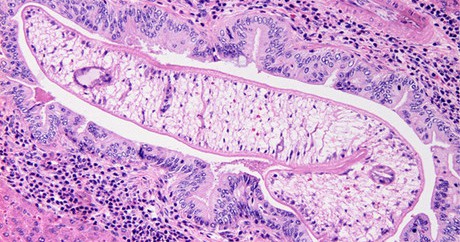
Scientists from the Centers for Disease Control and Prevention say it is one of the strangest and most unsettling cases they have ever encountered: Examining the rapidly growing lung tumors of critically ill Colombian man, the CDC researchers discovered that the masses weren’t made of human cells — they were from a tapeworm living inside him.
This is the first known report of a person becoming sick from cancer cells that developed in a parasite, the researchers reported in a study published Thursday in the New England Journal of Medicine
“We were amazed when we found this new type of disease — tapeworms growing inside a person, essentially getting cancer, that spreads to the person, causing tumors,” said study researcher Dr. Atis Muehlenbachs, a staff pathologist at the Centers for Disease Control and Prevention’s Infectious Diseases Pathology Branch (IDPB).
While scientists have long known that viruses and bacteria can cause cancer — the human papillomavirus (HPV) is linked to the development of cervical and anal cancers, and Helicobacter pylori bacteria is known to cause stomach cancer — there is no documented history of a tapewmorm doing the same.
“This is the first time we’ve seen parasite-derived cancer cells spreading within an individual,” he said. “This is a very unusual, very unique illness.”
The 41-year-old patient first went to doctors in Colombia after experiencing a fever, cough and weight loss for several months. The man had been diagnosed with HIV more than 10 years earlier, but was not taking his medications. HIV, which weakens the immune system, likely played a role in allowing the development of the parasite cancer, the researchers said.
A CT scan showed tumors in his lung and lymph nodes, but biopsies of these tumors revealed bizarre cells, leading the Colombian doctors to contact the CDC for assistance in diagnosing the man.

A CT scan of the front of the man’s chest, showing clusters of tumors made up of cancer cells from a tapeworm (Photo: Pontifical Bolivarian University, via the Washington Post)
As the researchers describe in the case report, the cells, when examined under a microscope, acted like cancer cells — they multiplied quickly and crowded together. But the cells didn’t appear to be human; for one thing, they were 10 times smaller than human cancer cells. After a number of tests, the researchers found DNA from a type of tapeworm called Hymenolepsis nana, or H. nana, in the man’s tumors.
At first, the researchers didn’t believe what they were seeing. “We knew invertebrates can grow tumors, but the fact that one can invade and disseminate in a human and make them sick just really, really defied belief,” Dr. Muehlenbachs told NPR. But after a “barrage of tests,” the CDC team concluded that the clusters of tumor cells were, indeed, caused by the tapeworm. Their conclusions have since been confirmed by other independent experts, the Washington Post reports.
The researchers hypothesized that, because the man had HIV, the tapeworm was able to keep growing in the body, unchecked by the immune system. Eventually, mutations developed in the tapeworm’s cells that turned the cells cancerous. By the time he sought treatment at the hospital, the tapeworm’s cancer cells “had formed blobs on the man’s lungs, liver and adrenal glands,” and his lymph nodes “had swollen to the size of golf balls, making it hard for him to move his head,” NPR reports.
The patient died just 72 hours after researchers determined that the tumors were caused by H. nana.
Also known as the dwarf tapeworm, H. nana is the most common tapeworm in humans, infecting up to 75 million people worldwide at any given time. Human infection usually occurs via accidental ingestion of the feces of another infected person. Most people infected with H. Nana don’t show symptoms, but in those with compromised immunity, the parasitic infection can turn serious and persist in a person’s body for years.
Although the Colombian man’s case is a rare one, the researchers noted that since both tapeworms and HIV affect millions of people globally, “there may be more cases that are unrecognized.”
If researchers do find other cases like this one, it’s not clear what type of treatment would help. Drugs that treat tapeworm infections may not be able to treat cancer cells from tapeworms, the researchers said. But it’s possible that human cancer treatment might also work against parasite cancer cells.
Dr. Muehlenbachs said the case also calls for further investigation of whether this phenomenon is limited to tapeworms, or if there could be some “underlying biological phenomena” that may cause transmissible cancer cells to develop in other living creatures that can them pass them along to humans.
